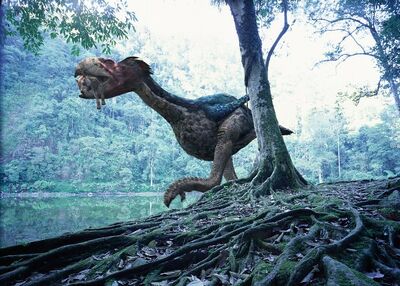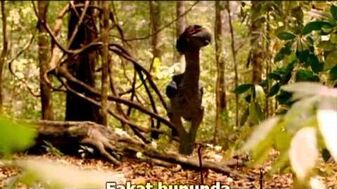
Gastornis as it appeared in Walking with Beasts, walking off with its prize, a Propalaeotherium
Gastornis meaning 'Gaston's Bird', was a large, omnivorous genus of flightless bird. Living during the Early Eocene Epoch mainly, though possibly originating from the depths of the Late Palaeocene Epoch, Gastornis was probably one of the apex predators that ruled over the plethora of small animals that had survived the K-T Extinction of 65 MYA. Gastornis was over 1.75 metres tall (5 feet 9 inches) and stood on two powerful and muscular, scaly legs.

Gastornis
These birds were shadows of the Dinosaurs in themselves, being descendants of the great reptiles. Heavily built and easily one of the largest animals around at the time, Gastornis could well have been a top predator, using the large 'hatchet' beak to literally crush the bones in the bodies of small mammals. However, some scientists speculate that this could be a beak designed for crushing nuts and tough vegetation instead.

Gastornis
In turn, it is argued that such a large bird could not possibly sustain itself on such poor grade food. It is widely agreed that Gastornis was predatory. Found in the famous German sites of Messel (The Messel Shales), and Geiseltal, they have also been found in similar sites in the USA. This great Neognath Bird, was probably an ambush predator, which specialised in hunting the small horses and such in the dark forest and jungle world of the Late Palaeocene and Early Eocene, 61-40 MYA.

Gastornis towers over the other Eocene Epoch animals, 49 MYA.